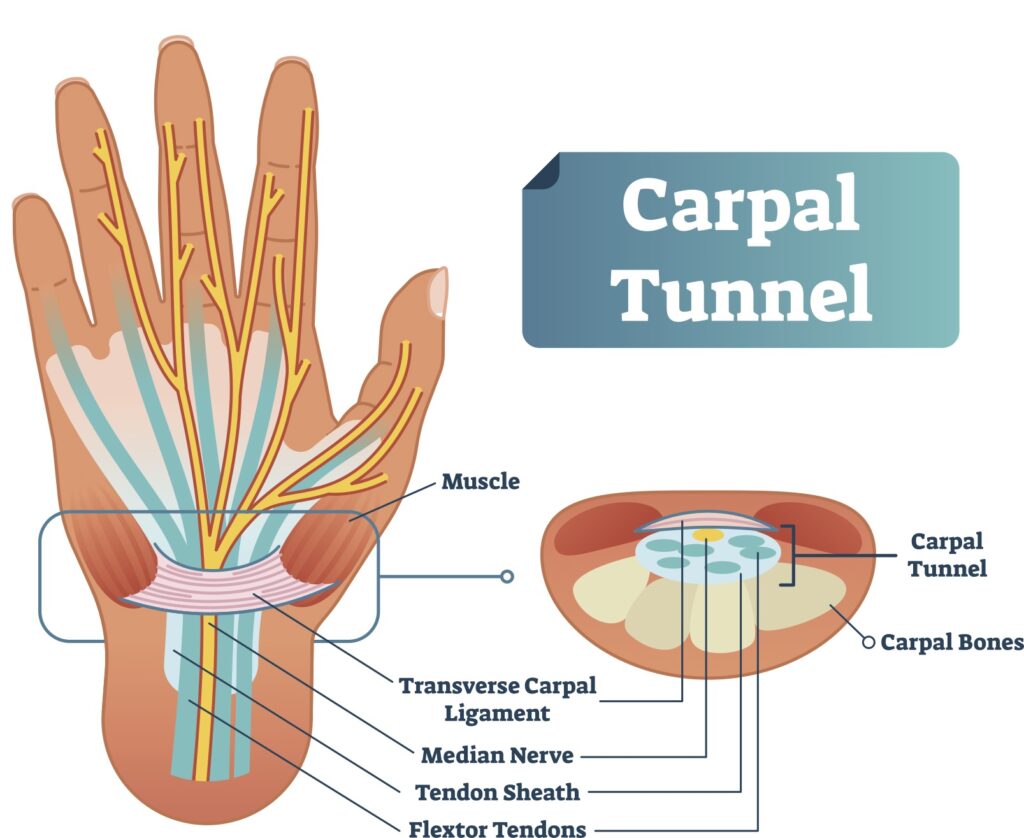Carpal tunnel syndrome is a painful health condition resulting from repetitive motions like painting, playing musical instruments and typing. Carpal tunnel, for some people, is a minor inconvenience because there is no pain, weakness or numbness. However, it may be debilitating for others to the point that it requires surgery. So, when is carpal tunnel bad enough for surgery? Let’s discuss at what stage of carpal tunnel syndrome you might consider surgery.
What is Carpal Tunnel Syndrome?
Carpal tunnel syndrome is a disruptive and painful condition that mostly affects the hand, wrist and arm. It occurs when the median nerve located in the wrist becomes compressed. The median nerve is responsible for hand sensation and muscle function.
Common symptoms of carpal tunnel include pain and tingling in the thumb or the first three fingers. As the disease progresses, numbness and a burning sensation may travel up your arm, causing discomfort.
Treatment for carpal tunnel varies depending on the severity of the condition and how long you’ve had it. If there are only minor symptoms like slight numbness, moving or shaking the arm should provide some relief. In more advanced cases, steroid medications and wrist splints help relieve symptoms, while extremely severe cases require surgery.

What are the Signs and Symptoms of Carpal Tunnel?
Common carpal tunnel symptoms include:
- Pan in the hand that may extend to the wrist
- Numbness and tingling in the hand
- A burning sensation in the fingers
- Pain that gets worse at night
- Hand weakness which might make you drop objects more often
For most people, these symptoms remain mild and come and go. Treatment in the early stages helps slow down the disease progression. Consider seeing a doctor if symptoms persist for more than two weeks and interfere with daily tasks and sleep.
If you don’t treat carpal tunnel syndrome, the symptoms can worsen, and some may even become permanent. That’s because the median nerve becomes so compressed that it interferes with blood supply damaging the nerve in the end. The result is loss of manual dexterity and permanent arm numbness. If you also don’t treat the condition, you may have to endure chronic pain all your life.
When Should You Consider Carpal Tunnel Syndrome Surgery?
So, when is carpal tunnel bad enough for surgery? There are various non-surgical treatment options for carpal tunnel. They include rest, wrist splints, non-steroidal anti-inflammatory drugs, and corticosteroid injections. So, at what point should you consider carpal tunnel surgery?
Surgery is usually the last option if your symptoms persist for 6 months or longer. Surgery is also recommended if other conservative treatments aren’t making a difference. If the pain is beginning to interrupt your everyday life, your doctor will likely suggest surgery. At the same time, a surgical remedy is an obvious treatment if all nerve tests indicate damage to the median nerve.
What Does Carpal Tunnel Syndrome Surgery Involve?
The goal of the surgery is mostly to relieve pressure on the median nerve, which is achieved by releasing or cutting the transverse carpal ligament. When performed by an expert hand surgeon, you should feel relief from symptoms. With carpal tunnel syndrome, there are normally two surgical options:
- Open surgery: The surgeon makes a two-inch incision through which they will cut the transverse carpal ligament. The incision makes it easy for the carpal tunnel to enlarge, decompressing the median nerve.
- Endoscopic surgery: This is less invasive and involves making two incisions through which the surgeon guides a tiny camera and the surgical tool to cut the ligament.
Both surgeries are performed on an outpatient basis, meaning you can go home the same day. Your wrist will be bandaged, and you’ll have a splint that should stay in place for 1 to 2 weeks to allow healing. Your doctor will give you post-surgical instructions, like sleeping with the hand propped on a pillow to reduce swelling.
After the procedure, your surgeon will set up an appointment with a hand therapist. Hand therapy is meant to support healing and restore wrist mobility. You’re free to resume normal activities 2 weeks following the procedure. Depending on how compressed the median nerve was, carpal tunnel surgery recovery may take between 4 to 6 weeks. For some, it can take up to 1 year to regain lost sensation and strength.
If you are experiencing pain, numbness and any other discomfort due to carpal tunnel syndrome, book a consultation today at the Harley Clinic to discuss your treatment options.













